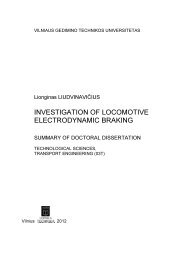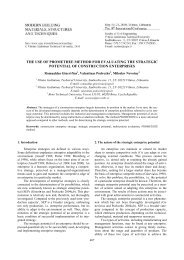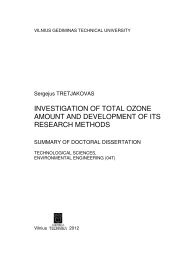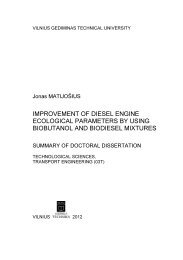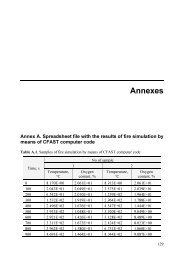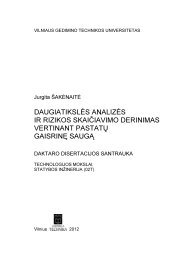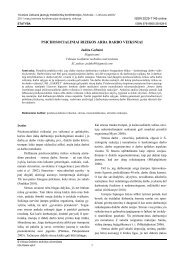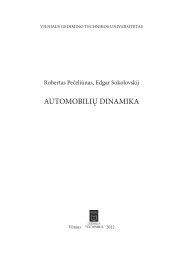898 peculiarities of passenger flows forecast on the reduced market ...
898 peculiarities of passenger flows forecast on the reduced market ...
898 peculiarities of passenger flows forecast on the reduced market ...
You also want an ePaper? Increase the reach of your titles
YUMPU automatically turns print PDFs into web optimized ePapers that Google loves.
ENVIRONMENTAL ENGINEERINGThe 8 th Internati<strong>on</strong>al C<strong>on</strong>ferenceMay 19–20, 2011, Vilnius, LithuaniaSelected papersISSN 2029-7106 print / ISSN 2029-7092 <strong>on</strong>lineISBN 978-9955-28-829-9 (3 Volume)ISBN 978-9955-28-827-5 (3 Volumes)http://enviro.vgtu.lt© Vilnius Gediminas Technical University, 2011PECULIARITIES OF PASSENGER FLOWS FORECAST ONTHE REDUCED MARKET CONDITIONSDaiva Griskeviciene 1 , Algirdas Griskevicius 2 , Ausrine Griskeviciute-Geciene 31, 2, 3 Vilnius Gediminas Technical University, Department <str<strong>on</strong>g>of</str<strong>on</strong>g> Transport Management, Plytines str. 27,LT-10223 Vilnius, Lithuania.E-mails: 1 griskeviciene.daiva@gmail.com; 2 griskevicius.algirdas@gmail.com; 3 ausrine.griskeviciute@vgtu.ltAbstract. The basic aim <str<strong>on</strong>g>of</str<strong>on</strong>g> public transport operator - Nati<strong>on</strong>al railway company – to provide <str<strong>on</strong>g>passenger</str<strong>on</strong>g>transportati<strong>on</strong> services <strong>on</strong> <strong>the</strong> territory <str<strong>on</strong>g>of</str<strong>on</strong>g> network accessibility areas, also to enlarge volumes <str<strong>on</strong>g>of</str<strong>on</strong>g> <str<strong>on</strong>g>passenger</str<strong>on</strong>g>transportati<strong>on</strong> and <strong>the</strong> quality <str<strong>on</strong>g>of</str<strong>on</strong>g> services necessary to satisfy needs <str<strong>on</strong>g>of</str<strong>on</strong>g> publicity and to reduce working loss.Accomplished overhaul <str<strong>on</strong>g>of</str<strong>on</strong>g> railway transport strategy and ec<strong>on</strong>omic analysis <str<strong>on</strong>g>of</str<strong>on</strong>g> present <str<strong>on</strong>g>passenger</str<strong>on</strong>g> transportati<strong>on</strong>activity allow defining features related to <strong>the</strong> selecti<strong>on</strong> <str<strong>on</strong>g>of</str<strong>on</strong>g> <str<strong>on</strong>g>forecast</str<strong>on</strong>g>ing methods. Important socio-ec<strong>on</strong>omic indicatorsselected as a frame for railway <str<strong>on</strong>g>passenger</str<strong>on</strong>g> transportati<strong>on</strong> <str<strong>on</strong>g>forecast</str<strong>on</strong>g>s were influenced by present statistic data andindicator reliability during <strong>the</strong> period <str<strong>on</strong>g>of</str<strong>on</strong>g> ec<strong>on</strong>omic crisis. Both ec<strong>on</strong>omic and social factors have influence <strong>on</strong><str<strong>on</strong>g>passenger</str<strong>on</strong>g> demand. Such indicators as GDP, average wages, level <str<strong>on</strong>g>of</str<strong>on</strong>g> automobilizati<strong>on</strong>, domestic income andexpenditures, demographical indicators, changes <strong>on</strong> urban territories, ec<strong>on</strong>omic changes, crisis cycle and o<strong>the</strong>r wereevaluated. The <str<strong>on</strong>g>forecast</str<strong>on</strong>g>s <strong>on</strong> <str<strong>on</strong>g>passenger</str<strong>on</strong>g> volumes transported by trains and routes <str<strong>on</strong>g>of</str<strong>on</strong>g> JC Lithuanian Railway areprepared for local and internati<strong>on</strong>al transportati<strong>on</strong>s. The priority is given to satisfacti<strong>on</strong> <str<strong>on</strong>g>of</str<strong>on</strong>g> <str<strong>on</strong>g>passenger</str<strong>on</strong>g> <strong>market</strong> demands<str<strong>on</strong>g>of</str<strong>on</strong>g>fering qualitative and quantitative balanced services. The <str<strong>on</strong>g>forecast</str<strong>on</strong>g>s <strong>on</strong> <str<strong>on</strong>g>passenger</str<strong>on</strong>g> transportati<strong>on</strong> demand areprepared according to three scenarios <str<strong>on</strong>g>of</str<strong>on</strong>g> basic <str<strong>on</strong>g>passenger</str<strong>on</strong>g> transportati<strong>on</strong> supply.Keywords: local <str<strong>on</strong>g>passenger</str<strong>on</strong>g> transportati<strong>on</strong>, railway transport operator, analysis <str<strong>on</strong>g>of</str<strong>on</strong>g> <str<strong>on</strong>g>passenger</str<strong>on</strong>g> prognosticati<strong>on</strong>providences and projecti<strong>on</strong>s, transportati<strong>on</strong> <str<strong>on</strong>g>forecast</str<strong>on</strong>g>ing.1. Introducti<strong>on</strong>It is complicated to <str<strong>on</strong>g>forecast</str<strong>on</strong>g> railway <str<strong>on</strong>g>passenger</str<strong>on</strong>g>transportati<strong>on</strong> volumes from a l<strong>on</strong>g-term perspective for aperiod <str<strong>on</strong>g>of</str<strong>on</strong>g> positive ec<strong>on</strong>omic development according tomethodical approach. Forecast is more difficult to beperformed for a period <str<strong>on</strong>g>of</str<strong>on</strong>g> general ec<strong>on</strong>omic depressi<strong>on</strong>and ec<strong>on</strong>omic crisis. Since sectors <str<strong>on</strong>g>of</str<strong>on</strong>g> Nati<strong>on</strong>al ec<strong>on</strong>omyare still not recovered after internati<strong>on</strong>al crisis it is not atime to <str<strong>on</strong>g>forecast</str<strong>on</strong>g> fur<strong>the</strong>r development <str<strong>on</strong>g>of</str<strong>on</strong>g> <strong>the</strong>m. Socialsector which potential directly reflects <strong>on</strong> c<strong>on</strong>sumpti<strong>on</strong>and <strong>market</strong> is in deeper and more complicated situati<strong>on</strong>.However it is necessary to predict processes <str<strong>on</strong>g>of</str<strong>on</strong>g>Nati<strong>on</strong>al ec<strong>on</strong>omic development, strategic planning, andpreparati<strong>on</strong> <str<strong>on</strong>g>of</str<strong>on</strong>g> priority projects, investment planning andimplementati<strong>on</strong>. It determines urgent modelling <str<strong>on</strong>g>of</str<strong>on</strong>g>perspectives <strong>on</strong> Nati<strong>on</strong>al ec<strong>on</strong>omy and transport sector,specific <str<strong>on</strong>g>forecast</str<strong>on</strong>g> <str<strong>on</strong>g>of</str<strong>on</strong>g> key railway activities. In order to gainthis aim <strong>the</strong> methodology applied for <strong>the</strong> <str<strong>on</strong>g>forecast</str<strong>on</strong>g>ing <str<strong>on</strong>g>of</str<strong>on</strong>g><str<strong>on</strong>g>passenger</str<strong>on</strong>g> <str<strong>on</strong>g>flows</str<strong>on</strong>g> transported by railway transport from al<strong>on</strong>g-term perspective is prepared. Internal and externalfactors, durati<strong>on</strong> <str<strong>on</strong>g>of</str<strong>on</strong>g> preparati<strong>on</strong> and implementati<strong>on</strong> <str<strong>on</strong>g>of</str<strong>on</strong>g>priority investment projects and necessity <str<strong>on</strong>g>of</str<strong>on</strong>g> <strong>the</strong>irsubstantiati<strong>on</strong> have influence <strong>on</strong> selected period for al<strong>on</strong>g-term perspective.In order to solve problems <str<strong>on</strong>g>of</str<strong>on</strong>g> applicati<strong>on</strong> <str<strong>on</strong>g>of</str<strong>on</strong>g> <str<strong>on</strong>g>forecast</str<strong>on</strong>g>methodology it is necessary to refer <strong>on</strong> integrated factorsdetermining opportunities <str<strong>on</strong>g>of</str<strong>on</strong>g> simulating situati<strong>on</strong>. Sincesubstantiati<strong>on</strong> <str<strong>on</strong>g>of</str<strong>on</strong>g> perspective projecti<strong>on</strong>s is an assessment<str<strong>on</strong>g>of</str<strong>on</strong>g> current situati<strong>on</strong> and retrospective development,detailed analysis <str<strong>on</strong>g>of</str<strong>on</strong>g> object activity and its change iscarried out. From <strong>on</strong>e hand, it is an analysis <str<strong>on</strong>g>of</str<strong>on</strong>g>quantitative change <str<strong>on</strong>g>of</str<strong>on</strong>g> substantial indexes; from ano<strong>the</strong>rhand, it is a qualitative analysis <str<strong>on</strong>g>of</str<strong>on</strong>g> <strong>the</strong>ir causality andeffects. Applying this principle <str<strong>on</strong>g>of</str<strong>on</strong>g> quantitative andqualitative development in this case, railway transportservices, it is obviously that quantitative change <str<strong>on</strong>g>of</str<strong>on</strong>g>transportati<strong>on</strong> activity indexes can also be analyzedqualitatively.Forecasts <str<strong>on</strong>g>of</str<strong>on</strong>g> <str<strong>on</strong>g>passenger</str<strong>on</strong>g> volumes transported by JCLithuanian Railways (fur<strong>the</strong>r – <strong>the</strong> Company) areperformed for local and internati<strong>on</strong>al transportati<strong>on</strong>routes and trains. Due to <strong>the</strong> l<strong>on</strong>ger period necessary torecover social sphere after <strong>the</strong> ec<strong>on</strong>omic crisis <strong>the</strong><str<strong>on</strong>g>forecast</str<strong>on</strong>g>s <str<strong>on</strong>g>of</str<strong>on</strong>g> <str<strong>on</strong>g>passenger</str<strong>on</strong>g> volumes are more moderate, butbasically optimistic.<str<strong>on</strong>g>898</str<strong>on</strong>g>
One <str<strong>on</strong>g>of</str<strong>on</strong>g> key tasks <str<strong>on</strong>g>of</str<strong>on</strong>g> <strong>the</strong> Company activity is toassure high transport speed <strong>on</strong> internati<strong>on</strong>al corridors; thisis related to <strong>the</strong> implementati<strong>on</strong> <str<strong>on</strong>g>of</str<strong>on</strong>g> infrastructure projects(for example - Rail Baltica). Very important task is toelectrify Trans-European transport corridors. Alsopriority is given to establishment and modern equipment<str<strong>on</strong>g>of</str<strong>on</strong>g> logistic centres.One <str<strong>on</strong>g>of</str<strong>on</strong>g> <strong>the</strong> most important trends <str<strong>on</strong>g>of</str<strong>on</strong>g> <strong>the</strong> EU andLithuanian transport policy is a pursuit to reinforceinteracti<strong>on</strong> between different transport modes. In order todevelop <str<strong>on</strong>g>passenger</str<strong>on</strong>g> transportati<strong>on</strong> it would c<strong>on</strong>sist <str<strong>on</strong>g>of</str<strong>on</strong>g>coordinati<strong>on</strong> <str<strong>on</strong>g>of</str<strong>on</strong>g> separate route services andimplementati<strong>on</strong> <str<strong>on</strong>g>of</str<strong>on</strong>g> “united ticket” c<strong>on</strong>cepti<strong>on</strong>. Moreover aprogram <str<strong>on</strong>g>of</str<strong>on</strong>g> renewal and modernizati<strong>on</strong> <str<strong>on</strong>g>of</str<strong>on</strong>g> <str<strong>on</strong>g>passenger</str<strong>on</strong>g>rolling-stock having influence <strong>on</strong> <str<strong>on</strong>g>passenger</str<strong>on</strong>g> trains todrive faster (speed 160 km/h) but more safety stillc<strong>on</strong>tinues to be implemented (The Lithuanian RailwayStrategy… 2008).2. Providences and Strategic Tasks for LocalPassenger Transportati<strong>on</strong>Results <str<strong>on</strong>g>of</str<strong>on</strong>g> analysis <str<strong>on</strong>g>of</str<strong>on</strong>g> <str<strong>on</strong>g>passenger</str<strong>on</strong>g> transportati<strong>on</strong> <strong>on</strong>local <strong>market</strong> showed that a number <str<strong>on</strong>g>of</str<strong>on</strong>g> <str<strong>on</strong>g>passenger</str<strong>on</strong>g>s usingrailway services permanently decreased even during aperiod <str<strong>on</strong>g>of</str<strong>on</strong>g> positive ec<strong>on</strong>omic development. This isc<strong>on</strong>cerned to: demographic changes in <strong>the</strong> country; decrease <str<strong>on</strong>g>of</str<strong>on</strong>g> inhabitant transport mobility; territorial redistributi<strong>on</strong> <str<strong>on</strong>g>of</str<strong>on</strong>g> work places awayfrom railway lines; territorial expansi<strong>on</strong> <str<strong>on</strong>g>of</str<strong>on</strong>g> small business andindustrial objects; decrease <str<strong>on</strong>g>of</str<strong>on</strong>g> number <str<strong>on</strong>g>of</str<strong>on</strong>g> employees; decrease <str<strong>on</strong>g>of</str<strong>on</strong>g> leisure <str<strong>on</strong>g>passenger</str<strong>on</strong>g> <strong>market</strong> due tohigh employment; disadvantageous railway routes and timeschedules;too small flexibility <str<strong>on</strong>g>of</str<strong>on</strong>g> railway transportcomparing to possibilities <str<strong>on</strong>g>of</str<strong>on</strong>g> road transportmeans, especially public transport.In Lithuania separate transport modes and <str<strong>on</strong>g>passenger</str<strong>on</strong>g>transport operators still are in high competiti<strong>on</strong>. Recentlyroad transport has <strong>the</strong> biggest part <str<strong>on</strong>g>of</str<strong>on</strong>g> <str<strong>on</strong>g>passenger</str<strong>on</strong>g>transportati<strong>on</strong> <strong>on</strong> regular routes, – approx. 97,3 %.Railway transport has <strong>on</strong>ly 2.2 % <str<strong>on</strong>g>of</str<strong>on</strong>g> total <str<strong>on</strong>g>passenger</str<strong>on</strong>g>transportati<strong>on</strong> volumes. Time and endeavour arenecessary for <strong>the</strong> Company to recover and attract<str<strong>on</strong>g>passenger</str<strong>on</strong>g>s.The reinforcement <str<strong>on</strong>g>of</str<strong>on</strong>g> Nati<strong>on</strong>al positi<strong>on</strong> is necessaryfor <strong>the</strong> maintenance and <strong>the</strong> development <str<strong>on</strong>g>of</str<strong>on</strong>g> <str<strong>on</strong>g>passenger</str<strong>on</strong>g>transport. In order to implement guideline <str<strong>on</strong>g>of</str<strong>on</strong>g> strategicdevelopment and particular means governmental andpublic instituti<strong>on</strong>s have to focus more attenti<strong>on</strong> tosupport harm<strong>on</strong>ized formati<strong>on</strong> <str<strong>on</strong>g>of</str<strong>on</strong>g> whole transport systemand <strong>the</strong> development <str<strong>on</strong>g>of</str<strong>on</strong>g> separate transport modes. In thissphere social reas<strong>on</strong>s exceed ec<strong>on</strong>omic <strong>on</strong>es; <strong>the</strong>reforedecisi<strong>on</strong> makers have to be prepared for this activity.The priority is given to <strong>the</strong> satisfacti<strong>on</strong> <str<strong>on</strong>g>of</str<strong>on</strong>g> <str<strong>on</strong>g>passenger</str<strong>on</strong>g><strong>market</strong> demands <str<strong>on</strong>g>of</str<strong>on</strong>g>fering quantitatively and qualitativelybalanced services. It would be purposeful for <strong>the</strong>Company to coordinate orders <strong>on</strong> <str<strong>on</strong>g>passenger</str<strong>on</strong>g>transportati<strong>on</strong> with municipalities, local authorities and<strong>the</strong> Ministry <str<strong>on</strong>g>of</str<strong>on</strong>g> Transport and Communicati<strong>on</strong> <str<strong>on</strong>g>of</str<strong>on</strong>g> <strong>the</strong>Republic <str<strong>on</strong>g>of</str<strong>on</strong>g> Lithuania (Griškevičienė D.; Griškevičius A. at.al. 2005, Griškevičienė D.; Heinitz F. M. at al.2008). Keytasks remains – to form and to motivate service demandaccording to social-ec<strong>on</strong>omic aspects (Butkevičius 2002,Butkevičius at al. 2008).It is purposeful complexly plan implementati<strong>on</strong> <str<strong>on</strong>g>of</str<strong>on</strong>g> apolicy <strong>on</strong> <str<strong>on</strong>g>passenger</str<strong>on</strong>g> and public transport support – toperform harm<strong>on</strong>ized coordinati<strong>on</strong> <str<strong>on</strong>g>of</str<strong>on</strong>g> all land transportmodes for local and internati<strong>on</strong>al transportati<strong>on</strong>s(Griškevičienė at. al.2006, Griškevičienė at al. 2008): to c<strong>on</strong>nect local railway and bus routes in spaceand time; to <str<strong>on</strong>g>of</str<strong>on</strong>g>fer adequate services for <str<strong>on</strong>g>passenger</str<strong>on</strong>g>s travellingby few transport modes; to improve discount system, persistent and unitedtickets seeking to attract c<strong>on</strong>stant <str<strong>on</strong>g>passenger</str<strong>on</strong>g> flow.It is purposeful to reinforce positi<strong>on</strong>s in <strong>the</strong> <strong>market</strong>in order to improve <strong>the</strong> activity <str<strong>on</strong>g>of</str<strong>on</strong>g> <str<strong>on</strong>g>passenger</str<strong>on</strong>g>transportati<strong>on</strong> (The Forecast <str<strong>on</strong>g>of</str<strong>on</strong>g> Freight and Passenger…2010): to make a l<strong>on</strong>g-term c<strong>on</strong>tracts between publicrailway transport operator and <strong>the</strong> Government <strong>on</strong>providing services and financial support allowingmethodically develop <str<strong>on</strong>g>passenger</str<strong>on</strong>g> transportati<strong>on</strong>activity for a l<strong>on</strong>ger period; to prepare standards <str<strong>on</strong>g>of</str<strong>on</strong>g> gradati<strong>on</strong> into classes andquality <str<strong>on</strong>g>of</str<strong>on</strong>g> railway transportati<strong>on</strong> servicesaccording to its potential and good worldwidepractice. to modernize existing trains and to add moresmaller (automotrice) or quickly changeablemodern capacities to rolling-stock fleet; to focus attenti<strong>on</strong> and to give more efforts to<strong>market</strong>ing means seeking to keep c<strong>on</strong>stant<str<strong>on</strong>g>passenger</str<strong>on</strong>g> flow and attract more new <str<strong>on</strong>g>passenger</str<strong>on</strong>g>s; to protect intercity and suburban rail routes forpotential <str<strong>on</strong>g>passenger</str<strong>on</strong>g> to use for:– daily journeys;– business and work journeys;– journeys through <strong>the</strong> territory <str<strong>on</strong>g>of</str<strong>on</strong>g> Lithuaniacombining with o<strong>the</strong>r transport modes andurban public transport;– leisure and weekend journeys;– occasi<strong>on</strong>al, holiday, tourism journeys.In order qualitatively improve <str<strong>on</strong>g>passenger</str<strong>on</strong>g>transportati<strong>on</strong> services it is purposeful to perform thisactivity during a middle-term perspective period:• to enlarge number <str<strong>on</strong>g>of</str<strong>on</strong>g> intercity and suburban trainroutes seeking to improve <strong>the</strong> selecti<strong>on</strong> <str<strong>on</strong>g>of</str<strong>on</strong>g> services<strong>on</strong> appropriate time; Due to this, a number <str<strong>on</strong>g>of</str<strong>on</strong>g> tripsand trains <strong>on</strong> route can be planned to be enlarged.• to introduce new and to recover suspended localroutes which were used by persistent <str<strong>on</strong>g>passenger</str<strong>on</strong>g>flow. Accomplished researches shows that<str<strong>on</strong>g>passenger</str<strong>on</strong>g>s can be attracted again;899
• to review <strong>the</strong> necessity <str<strong>on</strong>g>of</str<strong>on</strong>g> present routes, toreorganise <strong>the</strong>m meeting <str<strong>on</strong>g>passenger</str<strong>on</strong>g> needs, adjustingtraffic schedules, stops, starting and ending time;• if it is necessary, introduce seas<strong>on</strong>al, weekend,occasi<strong>on</strong>al routes/ trains showing c<strong>on</strong>cern andattenti<strong>on</strong> to <strong>the</strong> <str<strong>on</strong>g>passenger</str<strong>on</strong>g> needs;• changes in internati<strong>on</strong>al train traffic, formati<strong>on</strong> <str<strong>on</strong>g>of</str<strong>on</strong>g>new routes and start <str<strong>on</strong>g>of</str<strong>on</strong>g> important intercity trainshave influence <strong>on</strong> changes <str<strong>on</strong>g>of</str<strong>on</strong>g> local routes.Coherence <str<strong>on</strong>g>of</str<strong>on</strong>g> different levels <str<strong>on</strong>g>of</str<strong>on</strong>g> services can help toreceive better social-ec<strong>on</strong>omic effect. Moreover, <strong>the</strong>harm<strong>on</strong>izati<strong>on</strong> <str<strong>on</strong>g>of</str<strong>on</strong>g> railway service – route schedules -with o<strong>the</strong>r transport modes can stimulate <strong>the</strong>Company qualitatively improve activity andreinforce its competitiveness comparing with o<strong>the</strong>rtransport modes;• it is expected that route optimizati<strong>on</strong> in a l<strong>on</strong>g-termperspective will give positive effect minimizing<str<strong>on</strong>g>passenger</str<strong>on</strong>g> transportati<strong>on</strong> expenses and alsoattracting new <str<strong>on</strong>g>passenger</str<strong>on</strong>g>s <strong>on</strong> <strong>the</strong> branches, wheretrain traffic will be more compact;• Nati<strong>on</strong>al support and investment are necessary for<strong>the</strong> correcti<strong>on</strong> <str<strong>on</strong>g>of</str<strong>on</strong>g> <str<strong>on</strong>g>passenger</str<strong>on</strong>g> transportati<strong>on</strong> routes. Incase <str<strong>on</strong>g>of</str<strong>on</strong>g> insufficient Nati<strong>on</strong>al finance, <strong>the</strong> Companywill operate <strong>on</strong>ly <strong>the</strong>se routes, which will besubsidized;• it is purposeful to <str<strong>on</strong>g>of</str<strong>on</strong>g>fer steady ticket prices in orderto keep present <str<strong>on</strong>g>passenger</str<strong>on</strong>g>s. Decreasing <str<strong>on</strong>g>passenger</str<strong>on</strong>g><str<strong>on</strong>g>flows</str<strong>on</strong>g> as a result <str<strong>on</strong>g>of</str<strong>on</strong>g> worsen social c<strong>on</strong>diti<strong>on</strong>s can besupported applying <strong>market</strong>ing means;• Applying flexible system <str<strong>on</strong>g>of</str<strong>on</strong>g> rolling-stock capacityselecti<strong>on</strong>, bying more automatrice and shorter trains,expenditures <str<strong>on</strong>g>of</str<strong>on</strong>g> maintenance can be minimized inless busy routes, traffic <str<strong>on</strong>g>of</str<strong>on</strong>g> <strong>the</strong>se small trains can bedensified. This could help to recover shorted,<strong>reduced</strong> in number or suspended local routes.It is ec<strong>on</strong>omically purposeful to support and todevelop local <str<strong>on</strong>g>passenger</str<strong>on</strong>g> transportati<strong>on</strong> <strong>on</strong> <strong>the</strong> territory <str<strong>on</strong>g>of</str<strong>on</strong>g>Lithuania due to complete maintenance <str<strong>on</strong>g>of</str<strong>on</strong>g> availablepotential <strong>on</strong> infrastructure and rolling-stock; this potentialcould be maintain and supervised <strong>on</strong>ly using finance <str<strong>on</strong>g>of</str<strong>on</strong>g><strong>the</strong> Company (Butkevičius J.; Jarašūnienė, A, Jackiv, I…2008).Applying <strong>market</strong>ing means, paying more attenti<strong>on</strong>to <strong>the</strong> researches <str<strong>on</strong>g>of</str<strong>on</strong>g> <str<strong>on</strong>g>passenger</str<strong>on</strong>g> <strong>market</strong> and fundinginvestment projects local <str<strong>on</strong>g>passenger</str<strong>on</strong>g> transportati<strong>on</strong>services can be recovered and developed so, that<str<strong>on</strong>g>passenger</str<strong>on</strong>g> demand for <strong>the</strong>se services could be recoveredand formed again.3. Forecasts <str<strong>on</strong>g>of</str<strong>on</strong>g> Local Passenger Transportati<strong>on</strong>DemandThe <str<strong>on</strong>g>forecast</str<strong>on</strong>g>s <str<strong>on</strong>g>of</str<strong>on</strong>g> local <str<strong>on</strong>g>passenger</str<strong>on</strong>g> transportati<strong>on</strong>demand were based <strong>on</strong> three main scenario <str<strong>on</strong>g>of</str<strong>on</strong>g> <str<strong>on</strong>g>passenger</str<strong>on</strong>g>transportati<strong>on</strong> supply. These scenarios c<strong>on</strong>sider problems<str<strong>on</strong>g>of</str<strong>on</strong>g> possible railway supply, implementati<strong>on</strong> <str<strong>on</strong>g>of</str<strong>on</strong>g> investmentprojects and <strong>market</strong>ing means <strong>on</strong> railway transport,competiti<strong>on</strong> <str<strong>on</strong>g>of</str<strong>on</strong>g> alternative <str<strong>on</strong>g>passenger</str<strong>on</strong>g> transport modes,development <str<strong>on</strong>g>of</str<strong>on</strong>g> Nati<strong>on</strong>al ec<strong>on</strong>omy.Forecast scenarios. It is expected that transportmobility <str<strong>on</strong>g>of</str<strong>on</strong>g> inhabitants and public transport demand willincrease toge<strong>the</strong>r with <strong>the</strong> growth <str<strong>on</strong>g>of</str<strong>on</strong>g> Nati<strong>on</strong>al ec<strong>on</strong>omy.The Company will meet challenge to attract as many<str<strong>on</strong>g>passenger</str<strong>on</strong>g>s as possible <str<strong>on</strong>g>of</str<strong>on</strong>g>fering high quality services (TheForecasts <str<strong>on</strong>g>of</str<strong>on</strong>g> Freight and Passenger…. 2010).The optimistic scenario:1) Investment projects <strong>on</strong> infrastructuredevelopment, renewal <str<strong>on</strong>g>of</str<strong>on</strong>g> rolling-stock fleet andimprovement <str<strong>on</strong>g>of</str<strong>on</strong>g> <str<strong>on</strong>g>passenger</str<strong>on</strong>g> terminals will be prepared andimplemented;2) Due to implementing project <str<strong>on</strong>g>of</str<strong>on</strong>g> Rail Baltica andnew internati<strong>on</strong>al routes bigger intercity and suburban<str<strong>on</strong>g>passenger</str<strong>on</strong>g> <str<strong>on</strong>g>flows</str<strong>on</strong>g> will be formed;3) “Faster local railway transport” will bedeveloped combining with intensity and urban bus traffic.4) United ticket and o<strong>the</strong>r <strong>market</strong>ing means, trafficspeed accelerati<strong>on</strong> after <strong>the</strong> electrificati<strong>on</strong> <str<strong>on</strong>g>of</str<strong>on</strong>g> railway willattract new <str<strong>on</strong>g>passenger</str<strong>on</strong>g>s.The basic scenario:1) Due to implementati<strong>on</strong> <str<strong>on</strong>g>of</str<strong>on</strong>g> <strong>market</strong>ing means railwaytransport will reinforce its positi<strong>on</strong>s <strong>on</strong> localtransportati<strong>on</strong>;2) Rolling-stock fleet will be renewed progressively;3) Investment to railway infrastructure will beimplemented progressively;4) The project <str<strong>on</strong>g>of</str<strong>on</strong>g> Rail Baltica will be implementedwithout achievement <str<strong>on</strong>g>of</str<strong>on</strong>g> planned high traffic speed;5) Number <str<strong>on</strong>g>of</str<strong>on</strong>g> <str<strong>on</strong>g>passenger</str<strong>on</strong>g>s dealing with tourism andbusiness journeys will increase progressively.The pessimistic scenario:1) Investment projects meeting <strong>on</strong>ly freight demandswill be implemented in railway sector; rolling-stockfleet will not be renewed and no <strong>market</strong>ing meanswill be implemented;2) Due to competitiveness <str<strong>on</strong>g>of</str<strong>on</strong>g> o<strong>the</strong>r transport modesvolumes <str<strong>on</strong>g>of</str<strong>on</strong>g> local transportati<strong>on</strong> will decrease (due tocars and buses);3) “Faster local railway transport” will not bedeveloped and combined with intercity and urbanbus traffic;4) The project <str<strong>on</strong>g>of</str<strong>on</strong>g> Rail Baltica will be implemented <strong>on</strong>lytill Kaunas City without achievement <str<strong>on</strong>g>of</str<strong>on</strong>g> plannedhigh traffic speed;5) Due to political reas<strong>on</strong>s internati<strong>on</strong>al rail trafficthrough <strong>the</strong> territory <str<strong>on</strong>g>of</str<strong>on</strong>g> Lithuania will decrease.The „black” scenario:Passenger transportati<strong>on</strong> volumes <strong>on</strong> local routeswill decrease due to lost Nati<strong>on</strong>al support and crossfinancing from o<strong>the</strong>r activity causing shortening <str<strong>on</strong>g>of</str<strong>on</strong>g> routesand suspensi<strong>on</strong> <str<strong>on</strong>g>of</str<strong>on</strong>g> unpr<str<strong>on</strong>g>of</str<strong>on</strong>g>itable trips.According to <strong>the</strong> optimistic scenario local<str<strong>on</strong>g>passenger</str<strong>on</strong>g> transportati<strong>on</strong> volumes would increasefracti<strong>on</strong>ally and would reach approx. 4540 thsd.<str<strong>on</strong>g>passenger</str<strong>on</strong>g>s in <strong>the</strong> year 2015. Later <strong>the</strong> increase would befaster and would reach 8958 thsd. <str<strong>on</strong>g>passenger</str<strong>on</strong>g>s in <strong>the</strong> year2040.According to <strong>the</strong> basic scenario local <str<strong>on</strong>g>passenger</str<strong>on</strong>g>transportati<strong>on</strong> volumes would increase fracti<strong>on</strong>ally till <strong>the</strong>year 2015 – approx. 3874.3 thsd. <str<strong>on</strong>g>passenger</str<strong>on</strong>g>s. Later <strong>the</strong>900
increase would be c<strong>on</strong>sistent and would reach 6129.6thsd. <str<strong>on</strong>g>passenger</str<strong>on</strong>g>s in <strong>the</strong> year 2040.According to <strong>the</strong> pessimistic scenario local<str<strong>on</strong>g>passenger</str<strong>on</strong>g> transportati<strong>on</strong> volumes would decreasec<strong>on</strong>stantly and would reach approx. 3013.1 thsd.<str<strong>on</strong>g>passenger</str<strong>on</strong>g>s in <strong>the</strong> year 2015. Later <strong>the</strong> increase would befracti<strong>on</strong>al and would reach 4611.6 thsd. <str<strong>on</strong>g>passenger</str<strong>on</strong>g>s in <strong>the</strong>year 2040 due to usage <str<strong>on</strong>g>of</str<strong>on</strong>g> active <strong>market</strong>ing means.According to <strong>the</strong> “black” scenario local <str<strong>on</strong>g>passenger</str<strong>on</strong>g>transportati<strong>on</strong> volumes would decrease fracti<strong>on</strong>ally andwould reach approx. 1688.6 thsd. <str<strong>on</strong>g>passenger</str<strong>on</strong>g>s in <strong>the</strong> year2015. Later <strong>the</strong> decrease would be faster and would reach81.8 thsd. <str<strong>on</strong>g>passenger</str<strong>on</strong>g>s in <strong>the</strong> year 2040.Table 1 shows results <str<strong>on</strong>g>of</str<strong>on</strong>g> <str<strong>on</strong>g>forecast</str<strong>on</strong>g>s <str<strong>on</strong>g>of</str<strong>on</strong>g> <str<strong>on</strong>g>passenger</str<strong>on</strong>g>transportati<strong>on</strong> by Lithuanian Railways <strong>on</strong> local routes.Table 1. Passenger transportati<strong>on</strong> by Lithuanian Railways <strong>on</strong>local routes, thsdForecast 2010 2020 2030 2040Basic 3 278,3 4 713,7 5 523,4 6 129,6Optimistic 3 560,4 5 474,3 7 350,1 8 958,0Pessimistic 3 172,6 3 229,8 3 859,1 4 611,6“Black” 3 093,4 921,7 274,6 81,8It is expected that number <str<strong>on</strong>g>of</str<strong>on</strong>g> <str<strong>on</strong>g>passenger</str<strong>on</strong>g>s <strong>on</strong> localroutes will increase till 6.13 mill. Due to accepted andimplementing strategic and tactical means: start <str<strong>on</strong>g>of</str<strong>on</strong>g> newand renewal <str<strong>on</strong>g>of</str<strong>on</strong>g> existing routes, trip density; renovati<strong>on</strong> <str<strong>on</strong>g>of</str<strong>on</strong>g>rolling-stock fleet and modernizati<strong>on</strong> <str<strong>on</strong>g>of</str<strong>on</strong>g> railwayinfrastructure. Accelerati<strong>on</strong> <str<strong>on</strong>g>of</str<strong>on</strong>g> traffic speed, development<str<strong>on</strong>g>of</str<strong>on</strong>g> service variety and improvement <str<strong>on</strong>g>of</str<strong>on</strong>g> travel comfort alsoare urgent strategic tasks for <strong>the</strong> development <str<strong>on</strong>g>of</str<strong>on</strong>g><str<strong>on</strong>g>passenger</str<strong>on</strong>g> transportati<strong>on</strong>. It is expected that balance <str<strong>on</strong>g>of</str<strong>on</strong>g><str<strong>on</strong>g>passenger</str<strong>on</strong>g> demand and service supply will be achievedduring a middle-term perspective period. In order toreach <strong>the</strong>se aims internal and external c<strong>on</strong>diti<strong>on</strong>s arenecessary: high traffic speed, new modern trains,automatrice, flexible time schedules, modern system <str<strong>on</strong>g>of</str<strong>on</strong>g>ticket reservati<strong>on</strong> and purchase, qualitative <strong>market</strong>ingsystem. The effects <str<strong>on</strong>g>of</str<strong>on</strong>g> external factors are as follows: <strong>the</strong>maintenance <str<strong>on</strong>g>of</str<strong>on</strong>g> public transport services; <strong>the</strong> recovery <str<strong>on</strong>g>of</str<strong>on</strong>g>transportati<strong>on</strong> by railways; competitive ticket prices,increased fuel prices, new tax <str<strong>on</strong>g>of</str<strong>on</strong>g> polluti<strong>on</strong>, traffic jams inroad and street networks.4. Providences <str<strong>on</strong>g>of</str<strong>on</strong>g> Internati<strong>on</strong>al PassengerTransportati<strong>on</strong>The Company has to ensure <strong>the</strong> needs <str<strong>on</strong>g>of</str<strong>on</strong>g>internati<strong>on</strong>al transportati<strong>on</strong> by railway transport for <strong>the</strong>period till 2040:– <strong>the</strong> needs <str<strong>on</strong>g>of</str<strong>on</strong>g> local inhabitants, transportc<strong>on</strong>necti<strong>on</strong>s with <strong>the</strong> EU and o<strong>the</strong>r countries and fortransit transport crossing <strong>the</strong> territory <str<strong>on</strong>g>of</str<strong>on</strong>g> Lithuania. Forthis purpose modern equipped railway infrastructure,traffic safety organizati<strong>on</strong> and c<strong>on</strong>trol, appropriatemodern trains and flexible schedules, high traffic speed,attractive ticket prices and c<strong>on</strong>venient journey c<strong>on</strong>diti<strong>on</strong>s,coordinati<strong>on</strong> with o<strong>the</strong>r transport modes are necessary.– same activity to recover after <strong>the</strong> ec<strong>on</strong>omic crisisis expected in o<strong>the</strong>r countries. Socially this processproceeds l<strong>on</strong>ger than restructurizati<strong>on</strong> in ec<strong>on</strong>omy orbusiness sphere.– marginal positive progress or stabilizati<strong>on</strong> <str<strong>on</strong>g>of</str<strong>on</strong>g><str<strong>on</strong>g>passenger</str<strong>on</strong>g> <str<strong>on</strong>g>flows</str<strong>on</strong>g> are expected. Meanwhile qualitativechanges in <str<strong>on</strong>g>passenger</str<strong>on</strong>g> <strong>market</strong> are expected toge<strong>the</strong>r withquantitative development. Redistributi<strong>on</strong> betweenbusiness, leisure, tourism, cultural and communicati<strong>on</strong>journeys is expected too.– increase <str<strong>on</strong>g>of</str<strong>on</strong>g> number <str<strong>on</strong>g>of</str<strong>on</strong>g> <str<strong>on</strong>g>passenger</str<strong>on</strong>g>s <strong>on</strong>internati<strong>on</strong>al trains is expected during a middle-termperspective till <strong>the</strong> year 2020-2025. Expected effect isachieved by a help <str<strong>on</strong>g>of</str<strong>on</strong>g> development <str<strong>on</strong>g>of</str<strong>on</strong>g> internati<strong>on</strong>altransport c<strong>on</strong>diti<strong>on</strong>s and specific development <str<strong>on</strong>g>of</str<strong>on</strong>g> separatedirecti<strong>on</strong>s:1) Passengers are predicted to be transported <strong>on</strong>internati<strong>on</strong>al trains formed by <strong>the</strong> Company: <strong>on</strong> routes to East directi<strong>on</strong> <str<strong>on</strong>g>of</str<strong>on</strong>g> Transport CorridorIX increasing a number <str<strong>on</strong>g>of</str<strong>on</strong>g> trains or forming newtrains; <strong>on</strong> routes to North-South directi<strong>on</strong> <str<strong>on</strong>g>of</str<strong>on</strong>g> TransportCorridor I, specially <strong>on</strong> Rail Baltica, forming newinternati<strong>on</strong>al trains;2) Internati<strong>on</strong>al trains formed by railway companies <str<strong>on</strong>g>of</str<strong>on</strong>g>o<strong>the</strong>r countries: <strong>on</strong> routes to West directi<strong>on</strong> <str<strong>on</strong>g>of</str<strong>on</strong>g> Transport CorridorIX; new fast trains <strong>on</strong> routes <str<strong>on</strong>g>of</str<strong>on</strong>g> Transport Corridor I.– Due to <strong>the</strong> modernizati<strong>on</strong> <str<strong>on</strong>g>of</str<strong>on</strong>g> internati<strong>on</strong>altransportati<strong>on</strong> and <strong>the</strong> accelerati<strong>on</strong> <str<strong>on</strong>g>of</str<strong>on</strong>g> traffic speed, <strong>the</strong>improvement <str<strong>on</strong>g>of</str<strong>on</strong>g> internati<strong>on</strong>al ec<strong>on</strong>omic relati<strong>on</strong>s withneighbouring and remote countries, an increase <str<strong>on</strong>g>of</str<strong>on</strong>g><str<strong>on</strong>g>passenger</str<strong>on</strong>g> <str<strong>on</strong>g>flows</str<strong>on</strong>g> is expected during a l<strong>on</strong>g-termperspective till <strong>the</strong> year <str<strong>on</strong>g>of</str<strong>on</strong>g> 2040.– Passengers could be transported by internati<strong>on</strong>altrains formed by <strong>the</strong> Company and railway companies<str<strong>on</strong>g>of</str<strong>on</strong>g> o<strong>the</strong>r countries: <strong>on</strong> new routes to East directi<strong>on</strong> <str<strong>on</strong>g>of</str<strong>on</strong>g> TransportCorridor IX to visit capitals, large cities, ports,industrial centres and resorts; <strong>on</strong> routes to South directi<strong>on</strong> <str<strong>on</strong>g>of</str<strong>on</strong>g> Transport CorridorI to visit important cities <str<strong>on</strong>g>of</str<strong>on</strong>g> <strong>the</strong> EU countries.For this purpose it is necessary to ensure c<strong>on</strong>venientc<strong>on</strong>diti<strong>on</strong>s and Nati<strong>on</strong>al support for formati<strong>on</strong> <str<strong>on</strong>g>of</str<strong>on</strong>g>internati<strong>on</strong>al trains, traffic regulati<strong>on</strong> and serviceassurance. The Nati<strong>on</strong>al support is expedient duringshort and middle-term periods as current internati<strong>on</strong>altransportati<strong>on</strong>s are unpr<str<strong>on</strong>g>of</str<strong>on</strong>g>itable (due to relatively lowtariffs <str<strong>on</strong>g>of</str<strong>on</strong>g> <str<strong>on</strong>g>passenger</str<strong>on</strong>g> transportati<strong>on</strong> and low transportati<strong>on</strong>volumes). O<strong>the</strong>rwise <strong>the</strong> Company could implement <strong>on</strong>lypessimistic plans adjusting routes and schedules for <strong>the</strong>detriment <str<strong>on</strong>g>of</str<strong>on</strong>g> <str<strong>on</strong>g>passenger</str<strong>on</strong>g>s.Strategically developing internati<strong>on</strong>al <str<strong>on</strong>g>passenger</str<strong>on</strong>g>transportati<strong>on</strong> can attract own c<strong>on</strong>text <str<strong>on</strong>g>of</str<strong>on</strong>g> <str<strong>on</strong>g>passenger</str<strong>on</strong>g>s andincrease <strong>the</strong>ir <str<strong>on</strong>g>flows</str<strong>on</strong>g> due to competitive c<strong>on</strong>diti<strong>on</strong>s <str<strong>on</strong>g>of</str<strong>on</strong>g>journey and attractive ticket prices. The establishmentand <strong>the</strong> maintenance <str<strong>on</strong>g>of</str<strong>on</strong>g> attractive <strong>market</strong> are permanentactivities giving progressively improving results(Feasibility Study <str<strong>on</strong>g>of</str<strong>on</strong>g> Railway… 2007, <strong>the</strong> Forecast <str<strong>on</strong>g>of</str<strong>on</strong>g>901
Freight and Passenger…2010).After <strong>the</strong> implementati<strong>on</strong> <str<strong>on</strong>g>of</str<strong>on</strong>g> Rail Baltica project and<strong>the</strong> establishment <str<strong>on</strong>g>of</str<strong>on</strong>g> transit <str<strong>on</strong>g>passenger</str<strong>on</strong>g> terminal in Kaunas(and later in Vilnius), new flow <str<strong>on</strong>g>of</str<strong>on</strong>g> internati<strong>on</strong>al<str<strong>on</strong>g>passenger</str<strong>on</strong>g>s travelling from neighbouring and remotecountries <str<strong>on</strong>g>of</str<strong>on</strong>g> Asia through <strong>the</strong> territory <str<strong>on</strong>g>of</str<strong>on</strong>g> Lithuania to <strong>the</strong>countries <str<strong>on</strong>g>of</str<strong>on</strong>g> West Europe can be expected.5. Forecasts <str<strong>on</strong>g>of</str<strong>on</strong>g> Internati<strong>on</strong>al PassengerTransportati<strong>on</strong>Forecast scenarios. Due to adverse ec<strong>on</strong>omicc<strong>on</strong>diti<strong>on</strong>s after <strong>the</strong> ec<strong>on</strong>omic crisis both in Lithuania ando<strong>the</strong>r surrounding countries substantial changes ininternati<strong>on</strong>al <str<strong>on</strong>g>passenger</str<strong>on</strong>g> transportati<strong>on</strong> are not <str<strong>on</strong>g>forecast</str<strong>on</strong>g>edduring <strong>the</strong> early perspective till <strong>the</strong> year 2015. Thisperiod should not have c<strong>on</strong>siderable influence <strong>on</strong> routeredistributi<strong>on</strong> or change <str<strong>on</strong>g>of</str<strong>on</strong>g> <strong>the</strong>ir number.The <str<strong>on</strong>g>forecast</str<strong>on</strong>g> <str<strong>on</strong>g>of</str<strong>on</strong>g> internati<strong>on</strong>al <str<strong>on</strong>g>passenger</str<strong>on</strong>g>transportati<strong>on</strong> volumes are based <strong>on</strong> four scenarios.Insignificant positive development and stabilizati<strong>on</strong> <str<strong>on</strong>g>of</str<strong>on</strong>g><str<strong>on</strong>g>passenger</str<strong>on</strong>g> <str<strong>on</strong>g>flows</str<strong>on</strong>g> are expected realizing all scenarios(Griškevičienė at al.2006, The Forecasts <str<strong>on</strong>g>of</str<strong>on</strong>g> Friehgt andPassenger…2010).The optimistic scenario:1) Investment projects <strong>on</strong> infrastructure developmentwill be prepared, renewal <str<strong>on</strong>g>of</str<strong>on</strong>g> rolling-stock fleet and<strong>market</strong>ing means will be implemented;2) New internati<strong>on</strong>al routes will be opened (for example,Vilnius-Warsaw);3) The project <str<strong>on</strong>g>of</str<strong>on</strong>g> Rail Baltica will be implementedquicker;4) Transit traffic to Kaliningrad will increase;5) Accelerati<strong>on</strong> <str<strong>on</strong>g>of</str<strong>on</strong>g> <str<strong>on</strong>g>passenger</str<strong>on</strong>g> train traffic will reachEuropean standards.The basic scenario:1) Passenger rolling-stock fleet will be renewedprogressively;2) Investment to railway infrastructure and itsmodernizati<strong>on</strong> will be implemented moderately;3) Railway transport will reinforce its positi<strong>on</strong>s ininternati<strong>on</strong>al transportati<strong>on</strong> due to an implementati<strong>on</strong><str<strong>on</strong>g>of</str<strong>on</strong>g> <strong>market</strong>ing means;4) The project <str<strong>on</strong>g>of</str<strong>on</strong>g> Rail Baltica will be implementedwithout achievement <str<strong>on</strong>g>of</str<strong>on</strong>g> planned high traffic speed;5) Transit traffic to Kaliningrad will increaseprogressively.The pessimistic scenario:1) The implementati<strong>on</strong> <str<strong>on</strong>g>of</str<strong>on</strong>g> investment project issuspended. Due to a lack <str<strong>on</strong>g>of</str<strong>on</strong>g> financing <strong>the</strong>modernizati<strong>on</strong> <str<strong>on</strong>g>of</str<strong>on</strong>g> rolling-stock fleet is stopped andno <strong>market</strong>ing means are implemented;2) Volumes <str<strong>on</strong>g>of</str<strong>on</strong>g> internati<strong>on</strong>al transportati<strong>on</strong> willdecrease due to cheaper services in o<strong>the</strong>r countries;3) Cheap airlines and road transport will outrivalunattractive railway services <strong>on</strong> internati<strong>on</strong>altransportati<strong>on</strong>;4) Internati<strong>on</strong>al route Vilnius-Warsaw will not reachplanned attracti<strong>on</strong>;5) The project <str<strong>on</strong>g>of</str<strong>on</strong>g> Rail Baltica will be implemented<strong>on</strong>ly till Kaunas City without achievement <str<strong>on</strong>g>of</str<strong>on</strong>g>planned high traffic speed;6) Due to political reas<strong>on</strong>s transit traffic toKaliningrad will decrease;7) Internati<strong>on</strong>al transportati<strong>on</strong> will remain slow havinginflexible time schedules.According to <strong>the</strong> optimistic scenario internati<strong>on</strong>al<str<strong>on</strong>g>passenger</str<strong>on</strong>g> transportati<strong>on</strong> volumes would increase till1084 thsd. <str<strong>on</strong>g>passenger</str<strong>on</strong>g>s in <strong>the</strong> year 2015. Later <strong>the</strong> increasewould be till 2466.9 thsd. <str<strong>on</strong>g>passenger</str<strong>on</strong>g>s in <strong>the</strong> year 2040.According to <strong>the</strong> basic scenario internati<strong>on</strong>al<str<strong>on</strong>g>passenger</str<strong>on</strong>g> transportati<strong>on</strong> volumes would increase till888.9 thsd. <str<strong>on</strong>g>passenger</str<strong>on</strong>g>s in <strong>the</strong> year 2015. Later <strong>the</strong>increase would be till 1836.6 thsd. <str<strong>on</strong>g>passenger</str<strong>on</strong>g>s in <strong>the</strong> year2040.According to <strong>the</strong> pessimistic scenario internati<strong>on</strong>al<str<strong>on</strong>g>passenger</str<strong>on</strong>g> transportati<strong>on</strong> volumes would increase till725.7 thsd. <str<strong>on</strong>g>passenger</str<strong>on</strong>g>s in <strong>the</strong> year 2015. Later <strong>the</strong>increase would be till 1177.7 thsd. <str<strong>on</strong>g>passenger</str<strong>on</strong>g>s in <strong>the</strong> year2040.According to <strong>the</strong> “black” scenario internati<strong>on</strong>al<str<strong>on</strong>g>passenger</str<strong>on</strong>g> transportati<strong>on</strong> volumes would decrease till672.3 thsd. <str<strong>on</strong>g>passenger</str<strong>on</strong>g>s in <strong>the</strong> year 2015. Later <strong>the</strong>decrease would be till 44.2 thsd. <str<strong>on</strong>g>passenger</str<strong>on</strong>g>s in <strong>the</strong> year2040. O<strong>the</strong>r transport modes should be prepared to accept<str<strong>on</strong>g>passenger</str<strong>on</strong>g> <str<strong>on</strong>g>flows</str<strong>on</strong>g> from railway transport. Therefore a carusage would increase more to <strong>the</strong> complete c<strong>on</strong>gesti<strong>on</strong> <str<strong>on</strong>g>of</str<strong>on</strong>g>road highway network. Table 2 shows <str<strong>on</strong>g>forecast</str<strong>on</strong>g>s <str<strong>on</strong>g>of</str<strong>on</strong>g>internati<strong>on</strong>al <str<strong>on</strong>g>passenger</str<strong>on</strong>g> transportati<strong>on</strong> by LithuanianRailways till <strong>the</strong> year 2040.Table 2. Forecasts <str<strong>on</strong>g>of</str<strong>on</strong>g> internati<strong>on</strong>al <str<strong>on</strong>g>passenger</str<strong>on</strong>g> transportati<strong>on</strong> byLithuanian Railways till <strong>the</strong> year <str<strong>on</strong>g>of</str<strong>on</strong>g> 2040, thsdForecast 2010 2020 2030 2040Basic 789,6 1 245,2 1 704,4 1 836,6Optimistic 857,5 1 672,6 2 289,3 2 466,9Pessimistic 764,1 801,2 985,6 1 177,7„Black“ 735,2 592,9 288,4 44,2Expected effect <str<strong>on</strong>g>of</str<strong>on</strong>g> a middle-term perspective can beachieved by <strong>the</strong> help <str<strong>on</strong>g>of</str<strong>on</strong>g> development <str<strong>on</strong>g>of</str<strong>on</strong>g> internati<strong>on</strong>altransport c<strong>on</strong>diti<strong>on</strong>s and specific development <str<strong>on</strong>g>of</str<strong>on</strong>g> separatedirecti<strong>on</strong>s:1) Internati<strong>on</strong>al trains formed by <strong>the</strong> Company cantransport <str<strong>on</strong>g>passenger</str<strong>on</strong>g> <strong>on</strong>:̌ routes to East directi<strong>on</strong> <str<strong>on</strong>g>of</str<strong>on</strong>g> Transport Corridor IX:– Vilnius–Moscow (enlarge number <str<strong>on</strong>g>of</str<strong>on</strong>g> trains);– Vilnius–Minsk (enlarge number <str<strong>on</strong>g>of</str<strong>on</strong>g> trains);– Vilnius–Sankt Petersburg;– Vilnius–Kiev (form new train);̌ routes to North-South directi<strong>on</strong> <str<strong>on</strong>g>of</str<strong>on</strong>g> TransportCorridor I:− Vilnius–Riga (form new train);− Vilnius–Kaunas–Warsaw–Berlin (form newtrain after <strong>the</strong> implementati<strong>on</strong> <str<strong>on</strong>g>of</str<strong>on</strong>g> Rail Baltica);− Kaunas–Marijampole–Warsaw (combine withtrain Kaunas-Riga-Tallinn after <strong>the</strong>implementati<strong>on</strong> <str<strong>on</strong>g>of</str<strong>on</strong>g> Rail Baltica);902
2) Internati<strong>on</strong>al trains formed by railway companies <str<strong>on</strong>g>of</str<strong>on</strong>g>o<strong>the</strong>r countries can transport <str<strong>on</strong>g>passenger</str<strong>on</strong>g> <strong>on</strong>: routes to West directi<strong>on</strong> <str<strong>on</strong>g>of</str<strong>on</strong>g> Transport Corridor IX:− Moscow-Minsk–Vilnius-Kaliningrad.Expected effect <str<strong>on</strong>g>of</str<strong>on</strong>g> a l<strong>on</strong>g-term perspective can beachieved by <strong>the</strong> help <str<strong>on</strong>g>of</str<strong>on</strong>g> internati<strong>on</strong>al transportati<strong>on</strong>modernizati<strong>on</strong> and accelerati<strong>on</strong> <str<strong>on</strong>g>of</str<strong>on</strong>g> traffic speed, and alsoimprovement <str<strong>on</strong>g>of</str<strong>on</strong>g> ec<strong>on</strong>omic relati<strong>on</strong> between Lithuania,neighbouring and remote countries.Stimulating situati<strong>on</strong> <str<strong>on</strong>g>of</str<strong>on</strong>g> implementati<strong>on</strong> <strong>on</strong> fastrailway line Rail Baltica till Kaunas City it is determinedthat this line could redistribute <str<strong>on</strong>g>passenger</str<strong>on</strong>g> transportati<strong>on</strong><strong>market</strong> as follows:− fast railway could attract about 15-30 % <str<strong>on</strong>g>of</str<strong>on</strong>g> roadtransport <str<strong>on</strong>g>passenger</str<strong>on</strong>g>s driving to Warsaw and about40-60 % <str<strong>on</strong>g>of</str<strong>on</strong>g> road transport <str<strong>on</strong>g>passenger</str<strong>on</strong>g>s driving toBerlin;− fast railway could attract about 60 % <str<strong>on</strong>g>of</str<strong>on</strong>g> air transport<str<strong>on</strong>g>passenger</str<strong>on</strong>g> travelling to Warsaw and about 20-30 %<str<strong>on</strong>g>of</str<strong>on</strong>g> air transport <str<strong>on</strong>g>passenger</str<strong>on</strong>g>s travelling to Berlin,Hamburg, Amsterdam and o<strong>the</strong>r European cities;− Fast railway could attract about 40-50 % <str<strong>on</strong>g>of</str<strong>on</strong>g> bustransport <str<strong>on</strong>g>passenger</str<strong>on</strong>g>s travelling to Warsaw and about60-80 % <str<strong>on</strong>g>of</str<strong>on</strong>g> bus transport <str<strong>on</strong>g>passenger</str<strong>on</strong>g>s travelling toBerlin, Hamburg, Amsterdam, Paris and o<strong>the</strong>rEuorpean cities.− The opening <str<strong>on</strong>g>of</str<strong>on</strong>g> train Vilnius-Warsaw-Berlin couldalso increase internati<strong>on</strong>al <str<strong>on</strong>g>passenger</str<strong>on</strong>g> <str<strong>on</strong>g>flows</str<strong>on</strong>g>.During a l<strong>on</strong>g-term perspective internati<strong>on</strong>al trainsformed by <strong>the</strong> Company and o<strong>the</strong>r railway companies <str<strong>on</strong>g>of</str<strong>on</strong>g>foreign countries could transport <str<strong>on</strong>g>passenger</str<strong>on</strong>g>s <strong>on</strong>ly <strong>on</strong>sufficiently developed and modernized railwayinfrastructure:− <strong>on</strong> new routes to East directi<strong>on</strong> <str<strong>on</strong>g>of</str<strong>on</strong>g> TransportCorridor IX: to Ukraine (Odessa-Minsk-Vilnius-Kaunas-Klaipeda), Caucasus, Urals (Moscow-Vilnius-Kaunas-Klaipeda), resorts <str<strong>on</strong>g>of</str<strong>on</strong>g> <strong>the</strong> Black Sea, Moldova, countries<str<strong>on</strong>g>of</str<strong>on</strong>g> Middle Asia.− <strong>on</strong> routes to South directi<strong>on</strong> <str<strong>on</strong>g>of</str<strong>on</strong>g> Transport CorridorI: to Belgium, <strong>the</strong> Ne<strong>the</strong>rlands, Luxemburg, France,countries <str<strong>on</strong>g>of</str<strong>on</strong>g> Middle and East Europe, coasts <str<strong>on</strong>g>of</str<strong>on</strong>g> <strong>the</strong>Mediterranean Sea.th<strong>on</strong>s. pass.1200010000800060004000200002005Actual data200720092011Forecast201320152017201920212023General <str<strong>on</strong>g>passenger</str<strong>on</strong>g> <str<strong>on</strong>g>flows</str<strong>on</strong>g>Optimistic <str<strong>on</strong>g>forecast</str<strong>on</strong>g>Pessimistic <str<strong>on</strong>g>forecast</str<strong>on</strong>g>Fig 1. Forecast <str<strong>on</strong>g>of</str<strong>on</strong>g> general <str<strong>on</strong>g>passenger</str<strong>on</strong>g> <str<strong>on</strong>g>flows</str<strong>on</strong>g> transported byLithuanian Railways till <strong>the</strong> year 2040 (The <str<strong>on</strong>g>forecast</str<strong>on</strong>g>s <str<strong>on</strong>g>of</str<strong>on</strong>g>friehgt and <str<strong>on</strong>g>passenger</str<strong>on</strong>g> …)20252027202920312033203520372039Various efforts can enable to implement scenario <str<strong>on</strong>g>of</str<strong>on</strong>g>recommended development which could help to reachand keep 1.8 mills. <str<strong>on</strong>g>passenger</str<strong>on</strong>g>s transported byinternati<strong>on</strong>al trains in <strong>the</strong> end <str<strong>on</strong>g>of</str<strong>on</strong>g> <str<strong>on</strong>g>forecast</str<strong>on</strong>g>ed period.General <str<strong>on</strong>g>passenger</str<strong>on</strong>g> <str<strong>on</strong>g>flows</str<strong>on</strong>g> <str<strong>on</strong>g>forecast</str<strong>on</strong>g>ed till <strong>the</strong> year2040 are presented in figure 1.6. C<strong>on</strong>clusi<strong>on</strong>s1. The analysis <str<strong>on</strong>g>of</str<strong>on</strong>g> local <str<strong>on</strong>g>passenger</str<strong>on</strong>g> transportati<strong>on</strong> <strong>market</strong>showed that <strong>the</strong> decrease in local transportati<strong>on</strong> isrelated to both changes <str<strong>on</strong>g>of</str<strong>on</strong>g> demand and limitati<strong>on</strong> andflexibility <str<strong>on</strong>g>of</str<strong>on</strong>g> service supply.2. Railway transport has <strong>on</strong>ly 2 % <str<strong>on</strong>g>of</str<strong>on</strong>g> total <str<strong>on</strong>g>passenger</str<strong>on</strong>g>transportati<strong>on</strong> volumes. In order to keep present<str<strong>on</strong>g>passenger</str<strong>on</strong>g>s and attract new <strong>on</strong>es urgent means mustbe implemented by <strong>the</strong> Company;3. Due to adverse ec<strong>on</strong>omic c<strong>on</strong>diti<strong>on</strong>s after <strong>the</strong>ec<strong>on</strong>omic crisis both in Lithuania and o<strong>the</strong>rsurrounding countries substantial changes ininternati<strong>on</strong>al <str<strong>on</strong>g>passenger</str<strong>on</strong>g> transportati<strong>on</strong> are not<str<strong>on</strong>g>forecast</str<strong>on</strong>g>ed during <strong>the</strong> early perspective till <strong>the</strong> year2015. Meanwhile qualitative changes in <str<strong>on</strong>g>passenger</str<strong>on</strong>g><strong>market</strong> are expected toge<strong>the</strong>r with quantitativedevelopment.4. The Company has to ensure <strong>the</strong> needs <str<strong>on</strong>g>of</str<strong>on</strong>g>internati<strong>on</strong>al transportati<strong>on</strong>, transport c<strong>on</strong>necti<strong>on</strong>swith <strong>the</strong> EU and o<strong>the</strong>r countries and for transittransport crossing <strong>the</strong> territory <str<strong>on</strong>g>of</str<strong>on</strong>g> Lithuania for <strong>the</strong>period till 2040. For this purpose modern equippedrailway infrastructure, traffic safety organizati<strong>on</strong> andc<strong>on</strong>trol, appropriate modern trains and flexibleschedules, high traffic speed, attractive ticket pricesand c<strong>on</strong>venient journey c<strong>on</strong>diti<strong>on</strong>s, coordinati<strong>on</strong> witho<strong>the</strong>r transport modes are necessary.5. According to accomplished analysis and calculati<strong>on</strong>sit is recommended for <strong>the</strong> Company to c<strong>on</strong>tinueperform and improve activity <str<strong>on</strong>g>of</str<strong>on</strong>g> local <str<strong>on</strong>g>passenger</str<strong>on</strong>g>transportati<strong>on</strong> <str<strong>on</strong>g>of</str<strong>on</strong>g>fering attractive services andbalancing <strong>the</strong> questi<strong>on</strong> <str<strong>on</strong>g>of</str<strong>on</strong>g> financing support. It isec<strong>on</strong>omically purposeful to support and to developlocal <str<strong>on</strong>g>passenger</str<strong>on</strong>g> transportati<strong>on</strong> <strong>on</strong> <strong>the</strong> territory <str<strong>on</strong>g>of</str<strong>on</strong>g>Lithuania due to maintenance <str<strong>on</strong>g>of</str<strong>on</strong>g> available potential<strong>on</strong> infrastructure and rolling-stock; this potentialcould be maintain and supervised <strong>on</strong>ly using finance<str<strong>on</strong>g>of</str<strong>on</strong>g> <strong>the</strong> Company.6. Following basic guidelines <str<strong>on</strong>g>of</str<strong>on</strong>g> <strong>the</strong> EU transportpolicy stimulating <strong>the</strong> recovery <str<strong>on</strong>g>of</str<strong>on</strong>g> railway transportand <strong>the</strong> increase <str<strong>on</strong>g>of</str<strong>on</strong>g> railway <str<strong>on</strong>g>passenger</str<strong>on</strong>g> <strong>market</strong> it ispurposeful to increase a number <str<strong>on</strong>g>of</str<strong>on</strong>g> <str<strong>on</strong>g>passenger</str<strong>on</strong>g>sdoubly attracting new <str<strong>on</strong>g>passenger</str<strong>on</strong>g>s from o<strong>the</strong>rtransport modes having negative impacts <strong>on</strong>envir<strong>on</strong>ment and c<strong>on</strong>gesti<strong>on</strong> <str<strong>on</strong>g>of</str<strong>on</strong>g> infrastructure during<strong>the</strong> period <str<strong>on</strong>g>of</str<strong>on</strong>g> a l<strong>on</strong>g-term perspective.7. Despite <str<strong>on</strong>g>of</str<strong>on</strong>g> unpr<str<strong>on</strong>g>of</str<strong>on</strong>g>itable activity <str<strong>on</strong>g>of</str<strong>on</strong>g> local <str<strong>on</strong>g>passenger</str<strong>on</strong>g>transportati<strong>on</strong> this activity must be developed associal commitment to local inhabitants and has to besupported by <strong>the</strong> Government.8. In order to <str<strong>on</strong>g>of</str<strong>on</strong>g>fer qualitative and more attractiveservices and adapted rolling-stock fleet to local903
transportati<strong>on</strong> it is recommended to renew fast,electrified, short and l<strong>on</strong>g capacity trains andautomatrices having influence <strong>on</strong> <strong>the</strong> improvement<strong>on</strong> traffic schedules.9. Accelerating traffic speed a value <str<strong>on</strong>g>of</str<strong>on</strong>g> travel time willchange (decrease) and it will help trains to attract<str<strong>on</strong>g>passenger</str<strong>on</strong>g>s driving by cars during <strong>the</strong> period <str<strong>on</strong>g>of</str<strong>on</strong>g> amiddle-term perspective. Therefore it is purposefulto accelerate traffic speed <strong>on</strong> important branches <str<strong>on</strong>g>of</str<strong>on</strong>g>intercity transportati<strong>on</strong>. This is important to Vilnius-Kaunas branch where traffic speed will reach 160km/h after <strong>the</strong> implementati<strong>on</strong> <str<strong>on</strong>g>of</str<strong>on</strong>g> investmentprojects.10. It is purposeful complexly plan implementati<strong>on</strong> <str<strong>on</strong>g>of</str<strong>on</strong>g> apolicy <strong>on</strong> <str<strong>on</strong>g>passenger</str<strong>on</strong>g> and public transport support –to perform harm<strong>on</strong>ized coordinati<strong>on</strong> <str<strong>on</strong>g>of</str<strong>on</strong>g> all landtransport modes for local and internati<strong>on</strong>altransportati<strong>on</strong>s:– to c<strong>on</strong>nect local railway and bus routes inspace and time;– to <str<strong>on</strong>g>of</str<strong>on</strong>g>fer adequate services for <str<strong>on</strong>g>passenger</str<strong>on</strong>g>stravelling by few transport modes;– to improve discount system, persistent andunited tickets seeking to attract c<strong>on</strong>stant<str<strong>on</strong>g>passenger</str<strong>on</strong>g> flow.11. In order to improve activity <str<strong>on</strong>g>of</str<strong>on</strong>g> railway <str<strong>on</strong>g>passenger</str<strong>on</strong>g>transportati<strong>on</strong>s it is purposeful to reinforce itspositi<strong>on</strong> in <strong>the</strong> <strong>market</strong> paying more attenti<strong>on</strong> andefforts to implementati<strong>on</strong> <str<strong>on</strong>g>of</str<strong>on</strong>g> <strong>market</strong>ing means,opening <str<strong>on</strong>g>of</str<strong>on</strong>g> seas<strong>on</strong>al, weekend, occasi<strong>on</strong>al routesshowing c<strong>on</strong>cern and attenti<strong>on</strong> to <strong>the</strong> <str<strong>on</strong>g>passenger</str<strong>on</strong>g>needs, support <str<strong>on</strong>g>of</str<strong>on</strong>g> attractive ticket prices,modernizati<strong>on</strong> <strong>the</strong> system <str<strong>on</strong>g>of</str<strong>on</strong>g> ticket reservati<strong>on</strong> andpurchase.12. Strategically developing internati<strong>on</strong>al <str<strong>on</strong>g>passenger</str<strong>on</strong>g>transportati<strong>on</strong> can attract own c<strong>on</strong>text <str<strong>on</strong>g>of</str<strong>on</strong>g> <str<strong>on</strong>g>passenger</str<strong>on</strong>g>sand increase <strong>the</strong>ir <str<strong>on</strong>g>flows</str<strong>on</strong>g> due to competitivec<strong>on</strong>diti<strong>on</strong>s <str<strong>on</strong>g>of</str<strong>on</strong>g> journey and attractive ticket prices. Theestablishment and <strong>the</strong> maintenance <str<strong>on</strong>g>of</str<strong>on</strong>g> attractive<strong>market</strong> are permanent activities giving progressivelyimproving results. After <strong>the</strong> implementati<strong>on</strong> <str<strong>on</strong>g>of</str<strong>on</strong>g> RailBaltica project and <strong>the</strong> establishment <str<strong>on</strong>g>of</str<strong>on</strong>g> transit <str<strong>on</strong>g>passenger</str<strong>on</strong>g>terminal in Kaunas (and later in Vilnius), new flow <str<strong>on</strong>g>of</str<strong>on</strong>g>internati<strong>on</strong>al <str<strong>on</strong>g>passenger</str<strong>on</strong>g>s travelling from neighbouringand remote countries <str<strong>on</strong>g>of</str<strong>on</strong>g> Asia through <strong>the</strong> territory <str<strong>on</strong>g>of</str<strong>on</strong>g>Lithuania to <strong>the</strong> countries <str<strong>on</strong>g>of</str<strong>on</strong>g> West Europe can beexpected.ReferencesButkevičius, J. 2002. Passenger Transportati<strong>on</strong>: m<strong>on</strong>ograph.Vilnius Gediminas Technical University. Vilnius:Technika. 416 p. ISBN 9986055679.Butkevičius, J.; Jarašūnienė, A,; Jackiv, I. 2008. Comparis<strong>on</strong> <str<strong>on</strong>g>of</str<strong>on</strong>g>Passenger Transportati<strong>on</strong> by Lithuanian Road andRailway Transport in Regard to Traffic Safety. InProceedings <str<strong>on</strong>g>of</str<strong>on</strong>g> <strong>the</strong> 12th internati<strong>on</strong>al c<strong>on</strong>ference“Transport means–08”. October 23-24, 2008. KaunasTechnological University, Kaunas: Technologija. 147-150p.ISSN 1822-296X.European Commisi<strong>on</strong>. Directorate <str<strong>on</strong>g>of</str<strong>on</strong>g> General Regi<strong>on</strong>al Policy.2007. Feasibility Study <str<strong>on</strong>g>of</str<strong>on</strong>g> Railway “Rail Baltica”.Findings and guidelines. January, 2007. 18 p.Griškevičienė, D.; Griškevičius, A. 2006. The Complex Analysisand Forecasting <str<strong>on</strong>g>of</str<strong>on</strong>g> Passenger Transportati<strong>on</strong> by RailwayTransport in Lithuania. In Proceedings <str<strong>on</strong>g>of</str<strong>on</strong>g> internati<strong>on</strong>alc<strong>on</strong>ference „Transport means-2006“, KaunasTechnological University, Kaunas: Technologija. 174-177p.Griškevičienė, D.; Griškevičius, A. 2005. Feasibility Study <str<strong>on</strong>g>of</str<strong>on</strong>g>Intermodal Passenger in Lithuania. In selected papers <str<strong>on</strong>g>of</str<strong>on</strong>g><strong>the</strong> 6th internati<strong>on</strong>al c<strong>on</strong>ference “Envir<strong>on</strong>mentalEngineering”, Vol. 2. VGTU, Vilnius. 543-549 p.Griškevičienė, D.; Heinitz, F. M. 2008. The Analysis <str<strong>on</strong>g>of</str<strong>on</strong>g> <strong>the</strong>Accessibility <str<strong>on</strong>g>of</str<strong>on</strong>g> Passenger Transport System and <strong>the</strong>Comparis<strong>on</strong> with Social-Ec<strong>on</strong>omic Possibilities <str<strong>on</strong>g>of</str<strong>on</strong>g> Users.In Proceedings <str<strong>on</strong>g>of</str<strong>on</strong>g> <strong>the</strong> 12 th Internati<strong>on</strong>al C<strong>on</strong>ference„Transport means-08“,2008, October 23-24, KaunasTechnological University, Kaunas, „Technologija“, 231-234 p.The Forecasts <str<strong>on</strong>g>of</str<strong>on</strong>g> Freight and Passenger Volumes <strong>on</strong> LithuanianRailways till <strong>the</strong> Year 2040. Vilnius Gediminas TechnicalUniversity. Exec. Manager - Griškevičienė D. Vilnius.The Lithuanian Railway Strategy for <strong>the</strong> Year <str<strong>on</strong>g>of</str<strong>on</strong>g> 2008-2030.Lithuanian Railways. 2008. 114 p.904



